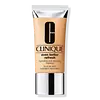Yves Saint Laurent Touche Éclat High Cover Radiant Concealer Versus Clinique Even Better Refresh Hydrating and Repairing Makeup
What's inside
What's inside
 Key Ingredients
Key Ingredients

 Benefits
Benefits

 Concerns
Concerns

 Ingredients Side-by-side
Ingredients Side-by-side

Water
Skin ConditioningCyclopentasiloxane
EmollientHydrogenated Polyisobutene
EmollientSorbitan Isostearate
EmulsifyingGlycerin
HumectantPropanediol
SolventPropylene Glycol
HumectantPhenoxyethanol
PreservativeMagnesium Sulfate
Disodium Stearoyl Glutamate
CleansingParaffin
PerfumingDisteardimonium Hectorite
StabilisingCera Microcristallina
Emulsion StabilisingCaprylyl Glycol
EmollientSilica Silylate
EmollientSynthetic Wax
AbrasiveCaffeine
Skin ConditioningAluminum Hydroxide
EmollientTocopherol
AntioxidantDisodium EDTA
Ethylhexyl Hydroxystearate
EmollientCalendula Officinalis Flower Extract
MaskingRuscus Aculeatus Root Extract
AstringentWater, Cyclopentasiloxane, Hydrogenated Polyisobutene, Sorbitan Isostearate, Glycerin, Propanediol, Propylene Glycol, Phenoxyethanol, Magnesium Sulfate, Disodium Stearoyl Glutamate, Paraffin, Disteardimonium Hectorite, Cera Microcristallina, Caprylyl Glycol, Silica Silylate, Synthetic Wax, Caffeine, Aluminum Hydroxide, Tocopherol, Disodium EDTA, Ethylhexyl Hydroxystearate, Calendula Officinalis Flower Extract, Ruscus Aculeatus Root Extract
Water
Skin ConditioningDimethicone
EmollientMethyl Trimethicone
Skin ConditioningTrimethylsiloxysilicate/Dimethiconol Crosspolymer
Butylene Glycol
HumectantPhenyl Trimethicone
Skin ConditioningNeopentyl Glycol Diheptanoate
EmollientNiacinamide
SmoothingHydroxyethyl Urea
HumectantPPG-12/Smdi Copolymer
EmollientLauryl PEG-9 Polydimethylsiloxyethyl Dimethicone
Skin ConditioningGlycerin
HumectantSodium Polyaspartate
HumectantPEG-10 Dimethicone
Skin ConditioningSigesbeckia Orientalis Extract
Skin ConditioningPolygonum Cuspidatum Root Extract
AntioxidantAcetyl Hexapeptide-8
HumectantSorbitol
HumectantIsopropyl Isostearate
EmollientPPG-15 Stearyl Ether
EmollientMicrococcus Lysate
Skin ConditioningResveratrol
AntioxidantPalmitoyl Hexapeptide-12
Skin ConditioningSalicylic Acid
MaskingCaffeine
Skin ConditioningPolysilicone-11
Sodium Chloride
MaskingTocopheryl Acetate
AntioxidantPolymethyl Methacrylate
Disteardimonium Hectorite
StabilisingDimethicone/PEG-10/15 Crosspolymer
Lecithin
EmollientTriethoxycaprylylsilane
Caprylyl Glycol
EmollientZinc Stearate
Cosmetic ColorantGlyceryl Polymethacrylate
Laureth-7
EmulsifyingTrehalose
HumectantTriethyl Citrate
MaskingSodium Hyaluronate
HumectantDimethicone Silylate
PEG-8
HumectantMagnesium Aluminum Silicate
AbsorbentMethicone
EmollientAlumina
AbrasiveSilica
AbrasivePropylene Glycol Caprylate
Skin ConditioningHexylene Glycol
EmulsifyingXanthan Gum
EmulsifyingDisodium EDTA
BHT
AntioxidantPotassium Sorbate
PreservativePhenoxyethanol
PreservativeMica
Cosmetic ColorantCI 77491
Cosmetic ColorantCI 77492
Cosmetic ColorantCI 77499
Cosmetic ColorantCI 77891
Cosmetic ColorantWater, Dimethicone, Methyl Trimethicone, Trimethylsiloxysilicate/Dimethiconol Crosspolymer, Butylene Glycol, Phenyl Trimethicone, Neopentyl Glycol Diheptanoate, Niacinamide, Hydroxyethyl Urea, PPG-12/Smdi Copolymer, Lauryl PEG-9 Polydimethylsiloxyethyl Dimethicone, Glycerin, Sodium Polyaspartate, PEG-10 Dimethicone, Sigesbeckia Orientalis Extract, Polygonum Cuspidatum Root Extract, Acetyl Hexapeptide-8, Sorbitol, Isopropyl Isostearate, PPG-15 Stearyl Ether, Micrococcus Lysate, Resveratrol, Palmitoyl Hexapeptide-12, Salicylic Acid, Caffeine, Polysilicone-11, Sodium Chloride, Tocopheryl Acetate, Polymethyl Methacrylate, Disteardimonium Hectorite, Dimethicone/PEG-10/15 Crosspolymer, Lecithin, Triethoxycaprylylsilane, Caprylyl Glycol, Zinc Stearate, Glyceryl Polymethacrylate, Laureth-7, Trehalose, Triethyl Citrate, Sodium Hyaluronate, Dimethicone Silylate, PEG-8, Magnesium Aluminum Silicate, Methicone, Alumina, Silica, Propylene Glycol Caprylate, Hexylene Glycol, Xanthan Gum, Disodium EDTA, BHT, Potassium Sorbate, Phenoxyethanol, Mica, CI 77491, CI 77492, CI 77499, CI 77891
Ingredients Explained
These ingredients are found in both products.
Ingredients higher up in an ingredient list are typically present in a larger amount.
Caffeine is most associated with coffee, tea, and cacao. In skincare, it helps with calming inflammation and is rich in antioxidants.
While caffeine is used to treat cellulite and and dark circles, further studies are needed to prove this. It has been believed to help with these skin conditions due to its ability to dilate blood vessels and increase blood flow.
Some studies are looking into caffeine's ability to protect against UV rays.
Learn more about CaffeineCaprylyl Glycol is a humectant and emollient, meaning it attracts and preserves moisture.
It is a common ingredient in many products, especially those designed to hydrate skin. The primary benefits are retaining moisture, skin softening, and promoting a healthy skin barrier.
Though Caprylyl Glycol is an alcohol derived from fatty acids, it is not the kind that can dry out skin.
This ingredient is also used as a preservative to extend the life of products. It has slight antimicrobial properties.
Learn more about Caprylyl GlycolDisodium EDTA plays a role in making products more stable by aiding other preservatives.
It is a chelating agent, meaning it neutralizes metal ions that may be found in a product.
Disodium EDTA is a salt of edetic acid and is found to be safe in cosmetic ingredients.
Learn more about Disodium EDTADisteardimonium Hectorite comes from the clay mineral named hectorite. It is used to add thickness to a product.
It can also help stabilize a product by helping to disperse other ingredients.
Hectorite is a rare, white clay mineral.
Learn more about Disteardimonium HectoriteGlycerin is already naturally found in your skin. It helps moisturize and protect your skin.
A study from 2016 found glycerin to be more effective as a humectant than AHAs and hyaluronic acid.
As a humectant, it helps the skin stay hydrated by pulling moisture to your skin. The low molecular weight of glycerin allows it to pull moisture into the deeper layers of your skin.
Hydrated skin improves your skin barrier; Your skin barrier helps protect against irritants and bacteria.
Glycerin has also been found to have antimicrobial and antiviral properties. Due to these properties, glycerin is often used in wound and burn treatments.
In cosmetics, glycerin is usually derived from plants such as soybean or palm. However, it can also be sourced from animals, such as tallow or animal fat.
This ingredient is organic, colorless, odorless, and non-toxic.
Glycerin is the name for this ingredient in American English. British English uses Glycerol/Glycerine.
Learn more about GlycerinPhenoxyethanol is a preservative that has germicide, antimicrobial, and aromatic properties. Studies show that phenoxyethanol can prevent microbial growth. By itself, it has a scent that is similar to that of a rose.
It's often used in formulations along with Caprylyl Glycol to preserve the shelf life of products.
Water. It's the most common cosmetic ingredient of all. You'll usually see it at the top of ingredient lists, meaning that it makes up the largest part of the product.
So why is it so popular? Water most often acts as a solvent - this means that it helps dissolve other ingredients into the formulation.
You'll also recognize water as that liquid we all need to stay alive. If you see this, drink a glass of water. Stay hydrated!
Learn more about Water